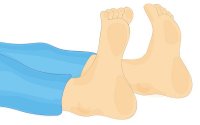Total Hip Replacement
Arthritis leads to the surfaces of the hip joint to wear away. The cartilage layer is damaged and lost and is no longer smooth, leading to stiffness and pain in the joint. Eventually the joint wears out to such an extent that the bone of the femoral head grinds on the bone of the acetabular socket.The main indication for a hip replacement is worsening pain that has not resolved with nonoperative measures (pain relief medications, weight loss, physiotherapy etc.) and is markedly affecting your quality of life.The prosthetic implant used in hip replacement consists of three parts: the acetabular cup, the femoral component, and the articular interface

Surgical Technique
Incisions: There are several approaches to the hip, depending on the preference of the surgeon – Posterior, Lateral, Antero-Lateral and Anterior. The length of the incision is about 15 to 20 cm.

Removing the femoral head: After exposure hip joint, cutting and removing the femoral head from the base of the neck.

Acetabulum Preparation: Cartilage and bone are removed from the acetabulum using a special semicircular drill that fit precisely to the acetabular cup.

Acetabular cup installation: The acetabular cup is the component which is placed into the acetabulum after determining the appropriate size and shape, attached using friction or cement, sometimes reinforced with screws.

Femoral canal preparation: Using special designed reamer bone is removed and the femur is shaped to accept the femoral stem.

Femoral implant insertion: The femoral component is the component that fits in the femur. Once the size and shape are determined, the femoral implant inserted into the femoral canal attached using friction or cement.

Articular Interface: The articular interface of the hip is a ball and socket joint. Size, material properties and machining tolerances at the articular interface can be selected based on patient demand to optimize (metal or ceramic ball)

Exercises to Prevent Post-Operative Complications:
1. Deep Breathing and Coughing
- This exercise can be performed in bed or in any other position (e.g. lying in bed or sitting in chair).
- Take five deep breaths followed by two to three coughs every 15 minutes.
- This should be performed every hour of the day that you are awake.
2. Ankle Pumping
- Lying on your back or sitting up in bed, move your ankles up and down as far as possible while keeping your legs straight.
- You may also move your ankles in circles.
- This should be performed every hour that you are awake, pumping each ankle 20 times.
- *If you keep your knee straight during this exercise you will feel a stretch in your calf muscles.



